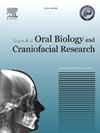Characterization of upper airway airflow dynamics in young adults with isolated Robin sequence: An exploratory investigation
Q1 Medicine
Journal of oral biology and craniofacial research
Pub Date : 2025-02-10
DOI:10.1016/j.jobcr.2025.01.009
引用次数: 0
Abstract
Impaired upper airway dimension in adults with Isolated Robin Sequence (IRS) can alter airflow dynamics, increasing the risk of pharyngeal collapse and the onset of obstructive sleep apnea. This study aimed to characterize the upper airways of six young adults (20.83 ± 6.40 years) with IRS, using computational fluid dynamics. Upper airways of six patients were reconstructed using 3D segmentation, generating unstructured hybrid meshes with ≥4 million tetrahedral elements. Flow simulations at 15 l/min were solved using the realizable k-ε model and the finite volume method. Morphophysiological variables assessed were: total airway volumes, minimal cross-sectional areas, average pressure, velocity magnitude, wall shear stress, turbulent kinetic energy (k) production, and resistance. Airway volume corresponded to 29.32 ± 4.65 cm³ and minimal cross-sectional area was 1.00 ± 0.55 cm2. Pressure drop, airway resistance to airflow, velocity of the airflow and turbulent kinetic energy corresponded to 31.341 ± 15.837 Pa, 0.125 ± 0.063 (Pa s/ml), 1.882 ± 0.514 (m/s) and 0.152 ± 0.056 (m2/s2). The total airway volume exhibited a strong negative correlation with airway resistance (−0.899) and the inlet-to-outlet pressure drop (−0.899). The minimal cross-sectional area of the pharynx at the retroglossal level showed a strong negative correlation (−0.912) with the area-weighted average velocity magnitude of the airflow and with k production (−0.924). In conclusion, airway volume reduction and retroglossal obstruction in young adults with IRS are associated with altered fluid flow characteristics, including increased velocity magnitude, pressure drop, resistance, and turbulent kinetic energy production. These changes may increase the effort to breathe and predispose patients to sleep-disordered breathing.

分离Robin序列的年轻成人上呼吸道气流动力学特征:一项探索性调查
成人孤立性罗宾序列(IRS)的上呼吸道尺寸受损可改变气流动力学,增加咽萎陷和阻塞性睡眠呼吸暂停发作的风险。本研究旨在利用计算流体动力学方法对6名患有IRS的年轻人(20.83±6.40岁)的上气道进行表征。对6例患者的上呼吸道进行三维分割重建,生成≥400万个四面体单元的非结构化混合网格。采用可实现的k-ε模型和有限体积法求解了15 l/min的流动模拟。评估的形态生理变量包括:气道总容积、最小横截面积、平均压力、速度大小、壁面剪切应力、湍流动能(k)产生和阻力。气道容积为29.32±4.65 cm³,最小横截面积为1.00±0.55 cm2。压降、气道气流阻力、气流速度和湍流动能分别为31.341±15.837 Pa、0.125±0.063 (Pa s/ml)、1.882±0.514 (m/s)和0.152±0.056 (m2/s2)。气道总容积与气道阻力(- 0.899)和气道进出口压降(- 0.899)呈较强的负相关。舌后水平咽部最小横截面积与气流面积加权平均速度大小(- 0.912)和产k量(- 0.924)呈强负相关(- 0.912)。综上所述,年轻IRS患者气道体积缩小和舌后梗阻与流体流动特性改变有关,包括流速大小、压降、阻力和湍流动能产生增加。这些变化可能会增加呼吸的努力,使患者容易出现睡眠呼吸障碍。
本文章由计算机程序翻译,如有差异,请以英文原文为准。
求助全文
约1分钟内获得全文
求助全文
来源期刊

Journal of oral biology and craniofacial research
Medicine-Otorhinolaryngology
CiteScore
4.90
自引率
0.00%
发文量
133
审稿时长
167 days
期刊介绍:
Journal of Oral Biology and Craniofacial Research (JOBCR)is the official journal of the Craniofacial Research Foundation (CRF). The journal aims to provide a common platform for both clinical and translational research and to promote interdisciplinary sciences in craniofacial region. JOBCR publishes content that includes diseases, injuries and defects in the head, neck, face, jaws and the hard and soft tissues of the mouth and jaws and face region; diagnosis and medical management of diseases specific to the orofacial tissues and of oral manifestations of systemic diseases; studies on identifying populations at risk of oral disease or in need of specific care, and comparing regional, environmental, social, and access similarities and differences in dental care between populations; diseases of the mouth and related structures like salivary glands, temporomandibular joints, facial muscles and perioral skin; biomedical engineering, tissue engineering and stem cells. The journal publishes reviews, commentaries, peer-reviewed original research articles, short communication, and case reports.
 求助内容:
求助内容: 应助结果提醒方式:
应助结果提醒方式:


